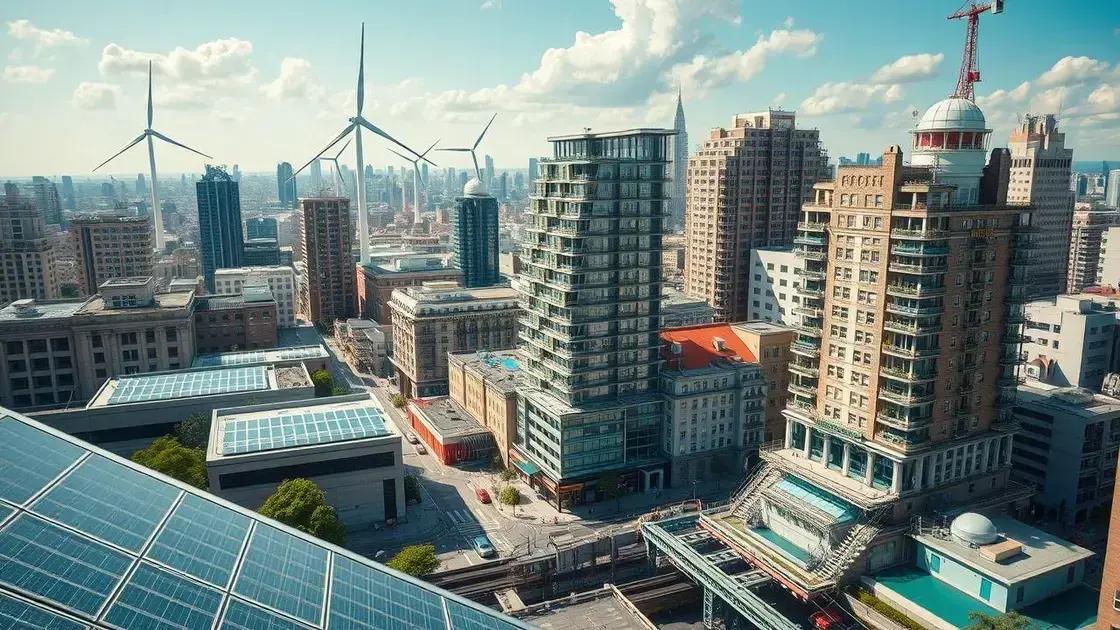Climate change impact: how it affects our future

Anúncios
Climate change impacts include increased temperatures, altered weather patterns, and significant effects on public health, necessitating effective strategies for mitigation and adaptation to ensure community resilience.
Climate change impact is a pressing issue that touches all aspects of our lives. How does it change our weather, health, and environment? Let’s dive into these critical effects that we face today.
Anúncios
Understanding the science behind climate change
Understanding the science behind climate change is essential for grasping its effects on our planet. At the heart of this issue is the greenhouse effect, which is caused by gases like carbon dioxide and methane trapping heat from the sun. These gases create a warming blanket around Earth, leading to numerous environmental changes.
Key Components of Climate Change
The key components of climate change include human activities, natural processes, and feedback loops. Human activities, particularly the burning of fossil fuels, release large amounts of greenhouse gases. This contributes significantly to the increasing temperatures we observe today.
Anúncios
- Fossil fuels are the leading source of emissions.
- Deforestation reduces the number of trees available to absorb carbon dioxide.
- Industrial processes release various pollutants into the atmosphere.
Natural processes such as volcanic eruptions can also contribute to climate variability, but human actions are the primary drivers of recent changes. Feedback loops further complicate the situation; for instance, melting ice reduces the Earth’s reflectivity, causing more heat absorption.
Evidence of Climate Change
Numerous indicators show the realities of climate change. From rising sea levels to shifting animal migration patterns, these signs point to a changing world. Extreme weather events, like hurricanes and wildfires, have become more frequent and intense, linked to our warming climate.
Scientists utilize various tools to observe these changes. Remote sensing technologies and climate models offer valuable insights into potential future scenarios. The data collected helps researchers understand trends, allowing for proactive measures to combat climate impacts.
By comprehending the scientific principles behind climate change, we can better address its consequences and work towards solutions. Being informed enables individuals and communities to take action, whether through reducing fossil fuel use or advocating for sustainable practices that protect our environment.
Practical effects of climate change on weather patterns

The practical effects of climate change on weather patterns are becoming increasingly evident. We are witnessing changes in temperature, precipitation, and storm intensity, all of which impact daily life. For instance, hotter summers and milder winters are now the norm in many regions.
Changes in Temperature
One major effect is the rise in average global temperatures. This warming trend leads to more frequent and intense heatwaves. Areas that were once temperate are now experiencing extreme temperatures, affecting agriculture and health.
- Heatwaves are longer and more severe.
- Temperatures are rising faster in polar regions.
- Urban areas are experiencing heat islands due to buildings and infrastructure.
These temperature variations can lead to unpredictable weather events. For example, a warm winter can lead to early blooms of flowers, which can then be damaged by late frosts. This disrupts local ecosystems and can impact food supplies.
Impacts on Precipitation
Alongside temperature changes, climate change is affecting rainfall patterns. Some regions are experiencing heavier rainfall and flooding, while others face drought conditions. This imbalance can lead to water shortages and affect crop yields.
In places prone to drought, the effects can be devastating. Agriculture relies heavily on consistent rainfall, and without it, food production suffers. Conversely, areas experiencing excessive rainfall may face flooding, which can displace communities and damage infrastructure.
As these changes continue, weather patterns are becoming less predictable. The increasing frequency of extreme weather events, such as hurricanes, typhoons, and heavy storms, is linked to the warming of ocean waters. Warmer waters provide more energy for storms, making them stronger and more destructive.
Understanding the practical effects of climate change on weather patterns is crucial for preparing for the future. By recognizing these changes, communities can develop better strategies to mitigate the impacts and adapt to new realities.
The influence of climate change on public health
The influence of climate change on public health is profound and multifaceted. As the climate warms, we see direct impacts on our health through increased heat-related illnesses, respiratory issues, and the spread of infectious diseases.
Heat-Related Health Issues
One significant effect of climate change is the rise in temperatures, leading to more heatwaves. These extreme temperatures can cause heat exhaustion and heatstroke, especially among vulnerable populations like the elderly and children. They are at higher risk during these periods and need extra protection.
- Going outside during peak hours can lead to heat exhaustion.
- Access to cooling centers is critical during heatwaves.
- Stay hydrated to prevent heat-related illnesses.
Additionally, cities often experience a phenomenon known as the urban heat island effect, where built environments trap heat. This exacerbates the risks for those living in densely populated areas.
Respiratory Issues Linked to Air Quality
Another way climate change can affect health is through air quality. Increasing temperatures can enhance the conditions for pollution and allergens. Higher levels of ozone and particulate matter can lead to respiratory problems, like asthma and allergies. As these pollutants become more prevalent, public health issues intensify.
Pollen seasons also lengthen due to warmer climates, worsening allergy outcomes for many people. As a result, those with pre-existing respiratory conditions may find their symptoms becoming more severe.
Vector-borne diseases also pose a growing threat. As the climate changes, the habitats of vectors like mosquitoes and ticks expand, increasing the likelihood of diseases such as malaria, dengue fever, and Lyme disease. Understanding these patterns can help with prevention and management efforts.
By recognizing the influence of climate change on public health, we can better prepare for these challenges. Engaging communities in awareness and action can help mitigate some impacts, leading to a healthier future in the face of changing environmental conditions.
Strategies for mitigation and adaptation

Strategies for mitigation and adaptation to climate change are critical for ensuring a sustainable future. While mitigation involves reducing greenhouse gas emissions, adaptation focuses on adjusting to the changes that are already occurring. Both approaches are necessary to protect our planet and communities.
Mitigation Strategies
Reducing emissions is key to combating climate change. There are several effective strategies for mitigation:
- Transition to renewable energy sources, such as wind, solar, and hydroelectric power.
- Enhance energy efficiency in homes and businesses to reduce overall energy consumption.
- Encourage carbon capture and storage technologies that can help reduce emissions from industrial sources.
Incorporating these strategies can significantly lower the carbon footprint of individuals and organizations. By embracing clean energy solutions, we can move towards a more sustainable future.
Adaptation Techniques
As we look towards adaptation, communities need to prepare for the impacts of climate change. Some effective adaptation techniques include:
- Developing infrastructure that can withstand extreme weather events, such as flood-resistant buildings.
- Implementing water management practices to address drought or flooding issues.
- Enhancing public health systems to prepare for climate-related health challenges.
These adaptation strategies are essential for reducing vulnerabilities in communities that are already facing the consequences of a changing climate. By investing in these approaches, we can build resilience against future impacts.
Combining both mitigation and adaptation strategies creates a comprehensive framework for addressing climate change. Educating communities and engaging businesses in sustainable practices is vital for fostering long-term change. When individuals work together, their collective action can lead to significant progress in tackling one of the most pressing challenges of our time.
FAQ – Frequently Asked Questions about Climate Change Impact
What are the main effects of climate change on weather patterns?
Climate change leads to increased temperatures, changing precipitation patterns, and more frequent extreme weather events like hurricanes and heatwaves.
How does climate change influence public health?
It increases heat-related illnesses, respiratory problems due to poor air quality, and the spread of vector-borne diseases.
What are some effective strategies for mitigating climate change?
Transitioning to renewable energy sources, enhancing energy efficiency, and utilizing carbon capture technologies can help reduce emissions.
What adaptation techniques can communities use to cope with climate change?
Developing resilient infrastructure, managing water resources, and enhancing public health systems are key adaptation techniques.





